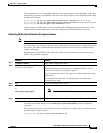
33-67
Catalyst 2960 and 2960-S Switch Software Configuration Guide
OL-8603-09
Chapter 33 Configuring QoS
Configuring Standard QoS
4 : 40 41 42 43 44 45 46 47 48 49
5 : 50 51 52 53 54 55 56 57 58 59
6 : 60 61 62 63
Note In the above DSCP-to-DSCP-mutation map, the mutated values are shown in the body of the matrix. The
d1 column specifies the most-significant digit of the original DSCP; the d2 row specifies the
least-significant digit of the original DSCP. The intersection of the d1 and d2 values provides the mutated
value. For example, a DSCP value of 12 corresponds to a mutated value of 10.
Configuring Ingress Queue Characteristics
Note Catalyst 2960-S switches do not support ingress queueing.
Depending on the complexity of your network and your QoS solution, you might need to perform all of
the tasks in the next sections. You will need to make decisions about these characteristics:
• Which packets are assigned (by DSCP or CoS value) to each queue?
• What drop percentage thresholds apply to each queue, and which CoS or DSCP values map to each
threshold?
• How much of the available buffer space is allocated between the queues?
• How much of the available bandwidth is allocated between the queues?
• Is there traffic (such as voice) that should be given high priority?
These sections contain this configuration information:
• Mapping DSCP or CoS Values to an Ingress Queue and Setting WTD Thresholds, page 33-67
(optional)
• Allocating Buffer Space Between the Ingress Queues, page 33-69 (optional)
• Allocating Bandwidth Between the Ingress Queues, page 33-70 (optional)
• Configuring the Ingress Priority Queue, page 33-71 (optional)
Mapping DSCP or CoS Values to an Ingress Queue and Setting WTD Thresholds
Note Catalyst 2960-S switches do not support ingress queueing.
You can prioritize traffic by placing packets with particular DSCPs or CoSs into certain queues and
adjusting the queue thresholds so that packets with lower priorities are dropped.


















